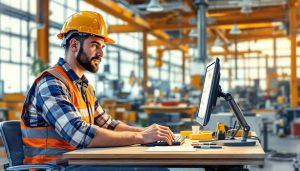How Predictive Maintenance Reduces Downtime and Costs is a hot topic for businesses in every industry. You know that unplanned downtime results in lost revenue and disrupts operations. But, did you know the true financial ramifications of downtime often extend far beyond those immediate impacts? We’ll analyze this and discuss how AI-driven predictive maintenance can revolutionize your approach to maintenance, optimize maintenance schedules, and lead to cost savings.
The True Cost of Downtime
The phrase “time is money” is especially relevant in the fast-paced business world. However, many companies overlook the significance of minimizing downtime. In manufacturing, unplanned downtime costs an estimated $50 billion each year.
These figures represent averages. Depending on the size and sector of your company, even a single hour offline can mean a significant financial hit. One report shares that this averages out to around $250,000 per hour. This underscores how crucial minimizing downtime is for maintaining a healthy bottom line.
Let’s examine why implementing a strategy for How Predictive Maintenance Reduces Downtime and Costs makes good business sense. It’s also wise to explore how embracing technology through an AI-driven approach can transform this from a necessary expense into a source of savings and greater efficiency.
Reactive, Preventative, and Predictive Maintenance

Traditionally, businesses relied on reactive or preventative maintenance. While these approaches have their merits, they fall short compared to a predictive model.
Reactive Maintenance
Reactive maintenance essentially means waiting for something to break before fixing it. While it may seem like the cheaper route initially, this approach often leads to more significant expenses in the long run.
Unforeseen equipment failures require immediate attention. This often means paying a premium for emergency repairs or expedited parts. Additionally, there’s no accounting for the impact these disruptions have on your production schedules.
Preventative Maintenance
This model emphasizes routinely scheduled maintenance tasks like inspections and part replacements. While this strategy promotes regularity, it isn’t always the most efficient approach.
Replacing parts that are still functional because they’ve hit a specific date or mileage marker increases costs and leads to unnecessary waste. Preventative maintenance, because it isn’t data-driven, often means companies end up over-maintaining or under-maintaining their equipment.
Predictive Maintenance
Now, we have arrived at a strategy that holds enormous potential: predictive maintenance. Instead of reacting to failure or sticking to a rigid schedule, this approach embraces cutting-edge technologies to forecast potential problems before they even surface. Predictive maintenance leverages data analysis and other maintenance technologies to predict equipment lifespan.
Harnessing the Power of AI and Data

AI-driven predictive maintenance gathers data through various sensors placed on your equipment. Think of it as attaching a Fitbit to your machines. These sensors keep a constant eye on vital health markers. This data is then analyzed by machine learning algorithms to identify patterns and predict potential issues.
This allows you to identify subtle performance shifts or anomalies in your equipment before they become major issues. Predictive maintenance solutions provide insights that can help extend equipment lifespan. You can optimize your maintenance schedule to perform repairs when truly needed rather than adhering to a predetermined timetable.
Switching to this method isn’t about merely swapping out how you fix your machines. It’s about transforming the way you approach the maintenance process in its entirety.
Think back to how doctors used to diagnose illness. Before we had X-rays, ultrasounds, and advanced blood work analysis, healthcare professionals relied primarily on observing symptoms. Now, doctors have an arsenal of high-tech diagnostic tools, enabling earlier detection, treatment, and even disease prevention.
Predictive maintenance allows you to approach equipment management similarly. Instead of reacting to failures, maintenance relies on data to anticipate and address issues in their early signs. Implementing predictive maintenance enables companies to take a more proactive approach to maintenance activities.
How Predictive Maintenance Reduces Downtime and Costs with Real-World Results
A Deloitte study found that implementing a predictive maintenance program resulted in a 15% reduction in downtime. In addition to keeping things running smoothly, it yielded a 20% improvement in labor productivity.
On top of all that, there was also a 30% drop in inventory costs, highlighting the value of aligning your stock with actual demand. This isn’t just some hypothetical possibility. There are real businesses across multiple sectors seeing substantial benefits by applying AI-powered solutions to address everyday operational challenges.
Take, for example, the case of an IT infrastructure provider. They adopted an AI-driven predictive maintenance platform to improve the management of their data center hard drives. The outcomes were substantial, to say the least, helping the company dodge what could have amounted to a staggering $100 million in costs related to fixing failed drives.
Another upside to a well-implemented approach for How Predictive Maintenance Reduces Downtime and Costs is a significant reduction in the likelihood of unexpected breakdowns, which then leads to improved workplace safety. Fewer malfunctions translate directly into fewer situations where workers could be injured due to equipment failure. These benefits aren’t just confined to sectors that have large, intricate physical machinery. This approach also leads to improved customer satisfaction due to increased equipment reliability and performance.
The research underscores how impactful making the switch can be for your organization. It’s not just about using tech for tech’s sake. This approach translates directly into tangible results across industries. Predictive maintenance stands as a testament to how data-driven decisions can optimize maintenance practices and enhance asset performance.
Understanding MTBF in Predictive Maintenance
Another bonus when examining How Predictive Maintenance Reduces Downtime and Costs involves its ability to automate MTBF calculations. This refers to mean time between failures, which is a crucial metric for evaluating the reliability of a product or a system.
Traditionally, calculating the MTBF was a cumbersome process relying on manual data entry and calculations. Predictive maintenance can automate this using data already collected through sensors, and applying intelligent algorithms to forecast future failures, and providing real-time visibility into your operations. This proactive approach helps identify potential risks and allows for timely intervention.
FAQs about How Predictive Maintenance Reduces Downtime and Costs
What is predictive maintenance?
Predictive maintenance involves using data, sensors, and analytics to forecast when equipment is likely to fail and proactively fix it before a breakdown occurs. Instead of simply reacting to failures, predictive maintenance focuses on understanding and predicting equipment conditions through real-time data, failure data, and advanced analytics.
Why does unplanned downtime happen so frequently?
Surprisingly, human error is cited as a bigger contributor to unplanned downtime compared to any other sector. Around 82% of companies surveyed reported at least one unplanned downtime event during the last 3 years, underscoring the prevalence of this issue.
This further highlights how data-driven, proactive solutions can be in addressing these issues, leading to more consistent operational efficiency and decreased costs. It’s clear that a forward-thinking approach centered around How Predictive Maintenance Reduces Downtime, and Costs benefits a company’s bottom line while also making their workplace safer. By leveraging maintenance solutions and embracing a data-driven approach, businesses can significantly minimize the occurrence of unplanned downtime.
What industries benefit from a predictive approach?
This approach isn’t limited to any specific niche or business size. The benefits span various sectors, such as:
- Manufacturing
- Energy
- Transportation
- Healthcare
- IT
Whether it’s reducing repair costs, extending equipment lifespan, or improving overall operational efficiency, predictive maintenance has emerged as a valuable tool for companies across industries. By predicting equipment failures and enabling proactive maintenance, businesses can avoid costly downtime and enhance their bottom line.
Conclusion
Switching from traditional methods like reactive and preventive maintenance to a cutting-edge, AI-driven, data-centric system offers substantial improvements on several fronts. By integrating data analytics, businesses can develop more precise maintenance strategies that anticipate equipment issues before they disrupt operations. This comprehensive approach allows companies to stay ahead of potential problems, effectively reducing downtime and costs.



